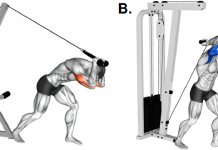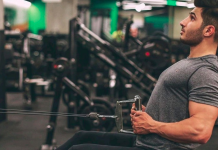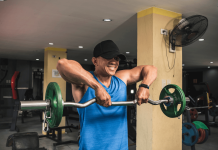Mastering Shoulder Flys: A Comprehensive Guide to Sculpted Shoulders
When it comes to achieving sculpted and well-defined shoulders, few exercises can match the effectiveness of shoulder flys. In this comprehensive guide, we will explore the different variations of shoulder flys, including shoulder cable flys and rear delt flys with dumbbells, and how to incorporate them into an efficient shoulder flys workout routine. Whether you are a beginner or a seasoned fitness enthusiast, this article will provide valuable insights and techniques to help you optimize your shoulder training and achieve remarkable results.
-
Understanding Shoulder Flys and Their Benefits
Shoulder flies are isolation exercises that primarily target the deltoid muscles, located in the shoulders. By performing shoulder flys, you engage the lateral, anterior, and posterior heads of the deltoids, leading to balanced shoulder development and improved shoulder stability.
Benefits of Shoulder Flys:
- Enhanced Shoulder Definition: Shoulder flies target specific shoulder muscle heads, contributing to a more sculpted and toned appearance.
- Increased Shoulder Strength: Regularly incorporating shoulder flys in your workout routine can help build shoulder strength and improve functional fitness.
- Improved Posture and Stability: Strong deltoids contribute to better posture and shoulder stability, reducing the risk of injuries.
-
Mastering Shoulder Cable Flys for Constant Tension
Shoulder cable flies are a variation of traditional shoulder flys that involve using cable machines. This exercise provides constant tension throughout the movement, engaging the shoulder muscles effectively.
How to Perform Shoulder Cable Flys: Step 1: Adjust the cable machine to shoulder height. Stand with feet shoulder-width apart and grasp the handles attached to the cables, one in each hand. Step 2: Start with your arms extended straight out to the sides, parallel to the floor, and maintain a slight bend in your elbows. Step 3: Inhale and engage your core. Slowly bring your arms forward, crossing them in front of your body, while maintaining the slight bend in your elbows. Step 4: Exhale as you return your arms to the starting position in a controlled manner. Step 5: Repeat for the desired number of repetitions.
Key Tips for Effective Shoulder Cable Flys:
- Focus on a slow and controlled movement to maximize muscle engagement and prevent jerking motions.
- Keep your shoulders down and back, maintaining proper posture throughout the exercise.
- Adjust the cable tension according to your fitness level to ensure a challenging yet manageable workout.

Sculpting Rear Delt Flys with Dumbbells for Strong Shoulders
The rear delt fly targets the posterior deltoids, which are often overlooked in shoulder training. Including rear delt flys with dumbbells in your routine helps create a well-rounded and proportionate shoulder appearance.
How to Perform Rear Delt Flys with Dumbbells: Step 1: Stand with feet shoulder-width apart, holding a dumbbell in each hand, palms facing inward. Step 2: Bend your knees slightly, hinge at your hips, and lean forward, maintaining a neutral spine. Step 3: Start with your arms hanging straight down, and with a slight bend in your elbows, lift both dumbbells out to the sides until your arms are parallel to the ground. Step 4: Squeeze your shoulder blades together at the top of the movement. Step 5: Lower the dumbbells back down in a controlled manner. Step 6: Repeat for the desired number of repetitions.
Key Tips for Effective Rear Delt Flys with Dumbbells:
- Engage your core to stabilize your body throughout the exercise.
- Avoid using excessive weight, focusing on proper form and a full range of motion.
- Maintain a slight bend in your elbows to reduce strain on the joints.
Stay tuned for the next part of this article, where we will explore different shoulder fly variations and workout routines to maximize your shoulder gains and achieve the sculpted shoulders you desire. Get ready to take your shoulder training to the next level!
Key Tips for Effective Rear Delt Flys with Dumbbells:
- Engage your core to stabilize your body throughout the exercise.
- Avoid using excessive weight, focusing on proper form and a full range of motion.
- Maintain a slight bend in your elbows to reduce strain on the joints.
Stay tuned for the next part of this article, where we will explore different shoulder fly variations and workout routines to maximize your shoulder gains and achieve the sculpted shoulders you desire. Get ready to take your shoulder training to the next level!
- Designing an Effective Shoulder Flys Workout Routine
To optimize your shoulder training and achieve significant gains, it’s crucial to structure a well-rounded shoulder flys workout routine. This section will outline a sample workout plan that incorporates various shoulder fly variations, ensuring comprehensive muscle engagement and progressive overload.
Sample Shoulder Flys Workout Routine:
- Warm-up: Begin with 5-10 minutes of light cardio to increase blood flow to the muscles. Follow this with dynamic shoulder stretches, such as arm circles and shoulder rotations, to improve mobility and reduce the risk of injury.
- Exercise 1: Dumbbell Shoulder Flys
- Sets: 4
- Repetitions: 12-15
- Rest: 60 seconds between sets
- Exercise 2: Shoulder Cable Flys
- Sets: 3
- Repetitions: 10-12
- Rest: 45 seconds between sets
- Exercise 3: Rear Delt Flys with Dumbbells
- Sets: 3
- Repetitions: 12-15
- Rest: 45 seconds between sets
- Exercise 4: Dumbbell Shoulder Press
- Sets: 3
- Repetitions: 10-12
- Rest: 60 seconds between sets
- Exercise 5: Bent-Over Dumbbell Reverse Flys
- Sets: 3
- Repetitions: 12-15
- Rest: 45 seconds between sets
- Exercise 6: Lateral Raises
- Sets: 3
- Repetitions: 12-15
- Rest: 45 seconds between sets
- Cool Down: Conclude the workout with static stretches for the shoulders and upper body. Hold each stretch for 20-30 seconds to improve flexibility and aid in recovery.
- Maximizing Shoulder Flys with Progressive Overload
To continue making progress and challenging your muscles, incorporating progressive overload is essential. Progressive overload involves gradually increasing the intensity of your workouts over time to stimulate muscle growth and strength gains.
Here are some tips to apply progressive overload to your shoulder flys workouts:
- Increase Resistance: Gradually add weight to your shoulder fly exercises as you become more comfortable with the current weight. This can be achieved by using heavier dumbbells or adjusting the cable machine’s weight stack.
- Vary Repetitions and Sets: Change the number of repetitions and sets for each exercise periodically. For example, you can perform lower repetitions with higher weight for strength gains or higher repetitions with moderate weight for muscular endurance.
- Control Tempo: Focus on controlling the eccentric (lowering) phase of the movement during shoulder flys. Slow and controlled repetitions can lead to greater muscle activation and hypertrophy.
Balancing Your Shoulder Workout for Optimal Results
While shoulder flys are excellent for targeting the deltoids, it’s crucial to create a balanced workout routine that incorporates exercises for all major muscle groups in the upper body. Neglecting other muscle groups can lead to muscular imbalances and potential injuries.
To achieve a well-rounded shoulder workout, consider incorporating the following exercises:
- Shoulder Press: Targets the entire deltoid muscle group, providing overall shoulder strength and development.
- Push-Ups: Engage the chest, triceps, and anterior deltoids, providing a compound movement for upper body strength.
- Rows: Target the upper back and rear deltoids, promoting a strong and stable upper body.
- Bicep Curls: Strengthen the biceps, which assist in various shoulder movements.
Injury Prevention and Proper Form
While shoulder flys are effective for shoulder development, it’s essential to prioritize safety and proper form during your workouts. Incorrect form can lead to injuries, particularly in the shoulder area, which is susceptible to strains and imbalances.
Follow these guidelines to ensure injury prevention and proper form during shoulder flys:
- Warm-up: Always warm up your shoulders and upper body before starting your shoulder flys workout. Engage in dynamic stretches and light movements to increase blood flow and loosen up the muscles.
- Mind-Muscle Connection: Focus on the mind-muscle connection during shoulder flys. Concentrate on feeling the tension in your deltoids, ensuring they are doing the work rather than relying on other muscle groups.
- Controlled Movement: Perform shoulder flys with slow and controlled movements. Avoid swinging the weights or using momentum to lift the dumbbells or cables. This will enhance muscle engagement and reduce the risk of strain or injury.
- Range of Motion: Work within a comfortable range of motion that allows you to maintain proper form. Avoid lifting the weights too high or excessively stretching your shoulders, as this can lead to injury.
- Monitor Shoulder Alignment: Keep an eye on your shoulder alignment during shoulder cable flys and dumbbell flys. Shoulders should be level and stable throughout the exercise.
Personalizing Your Shoulder Flys Routine
Every individual’s body is unique, and what works for one person may not be suitable for another. Personalize your shoulder flys routine based on your fitness level, goals, and any specific considerations.
Consider the following factors while personalizing your shoulder flys routine:
- Fitness Level: Beginners should start with lighter weights and fewer repetitions, gradually increasing the intensity as they become more experienced.
- Repetitions and Sets: Adjust the number of repetitions and sets based on your training goals. Higher repetitions may focus on muscle endurance, while lower repetitions with heavier weights can target muscle strength.
- Rest Periods: Tailor your rest periods between sets to match your recovery needs and workout intensity.
- Integrate Supersets: Incorporate supersets, which involve pairing different shoulder exercises back-to-back with minimal rest. This technique can increase workout intensity and efficiency.
- Listen to Your Body: Pay attention to how your body responds to the workout routine. If you experience pain or discomfort, adjust your form or modify the exercises to prevent injury.
Tracking Progress and Celebrating Achievements
Tracking your progress is crucial to understanding the effectiveness of your shoulder flys routine and staying motivated. Keep a workout journal to record your exercise performance, weights used, and any improvements over time.
Celebrate your achievements, no matter how small they may seem. Consistent progress and dedication are key to achieving long-term shoulder gains and overall fitness success.
Shoulder flys are an excellent addition to any shoulder workout routine, promoting well-rounded development and strength in the deltoid muscles. By incorporating various shoulder fly variations, applying progressive overload principles, and prioritizing proper form, you can optimize your shoulder training for remarkable results.
Remember to personalize your workout routine to align with your fitness level and goals, while also paying attention to injury prevention and listening to your body. By tracking your progress and celebrating your achievements, you’ll stay motivated and committed to your shoulder flys journey.
So, take this knowledge and apply it to your workouts, as you embark on the path to sculpted and powerful shoulders. With dedication and consistency, you’ll undoubtedly soar to new heights in your fitness journey. Happy shoulder flys and happy training!
Frequently Asked Questions (FAQs) About Shoulder Flys
What are shoulder flys?
Shoulder flys are isolation exercises that target the deltoid muscles, located in the shoulders. They involve lifting weights in a controlled manner to engage the shoulder muscles.
What are the benefits of shoulder flys?
Shoulder flys can help enhance shoulder definition, increase shoulder strength, and improve posture and stability.
Can beginners perform shoulder flys?
Yes, beginners can perform shoulder flys. It’s essential to start with lighter weights and focus on proper form and technique.
Are there different types of shoulder flys?
Yes, variations of shoulder flys include dumbbell shoulder flys, cable shoulder flys, and machine shoulder flys.
How do I perform dumbbell shoulder flys?
Hold a dumbbell in each hand, start with arms at your sides, and raise them out to the sides until parallel to the floor. Lower back down in a controlled manner.
What is the difference between shoulder flys and shoulder presses?
Shoulder flys primarily target the lateral deltoids, while shoulder presses engage all three deltoid heads and the triceps.
Are shoulder flys suitable for women?
Yes, shoulder flys are suitable for both men and women and can help tone and strengthen the shoulder muscles.
Can I do shoulder flys at home without weights?
Yes, you can perform bodyweight shoulder flys by using resistance bands or simply using your body’s weight.
How often should I include shoulder flys in my workout routine?
It is recommended to include shoulder flys in your workout routine 2-3 times per week with rest days in between.
What should I avoid while performing shoulder flys?
Avoid using excessive weight, swinging the arms, or rounding the shoulders to prevent injuries.
Do shoulder flys help reduce shoulder pain?
Shoulder flys can strengthen the shoulder muscles and potentially alleviate pain caused by muscle imbalances or weakness.
Can I combine shoulder flys with other shoulder exercises?
Yes, combining shoulder flys with shoulder presses, lateral raises, and other shoulder exercises can create a comprehensive shoulder workout.
Should I perform shoulder flys with high repetitions or heavy weights?
It depends on your fitness goals. Higher repetitions can focus on muscle endurance, while heavier weights can target muscle strength.
Can shoulder flys help improve my posture?
Yes, strong shoulder muscles developed through shoulder flys can contribute to better posture.
Is it essential to warm up before performing shoulder flys?
Yes, warming up helps prepare your muscles and joints for the exercise, reducing the risk of injury.
Can I do shoulder flys if I have a shoulder injury?
It is advisable to consult a healthcare professional before performing shoulder flys if you have a shoulder injury.
What is the proper breathing technique during shoulder flys?
Inhale during the eccentric (lowering) phase and exhale during the concentric (lifting) phase of the movement.
How can I progress in my shoulder flys routine?
Progress by gradually increasing the weight, adjusting repetitions, and incorporating advanced variations.
Are there any alternatives to shoulder flys for shoulder development?
Yes, exercises like shoulder presses, lateral raises, and upright rows can also contribute to shoulder development.
Can I do shoulder flys on the same day as chest exercises?
It is possible, but it’s essential to give your muscles adequate rest and recovery between workouts.




